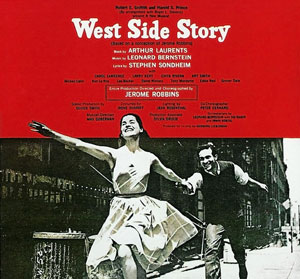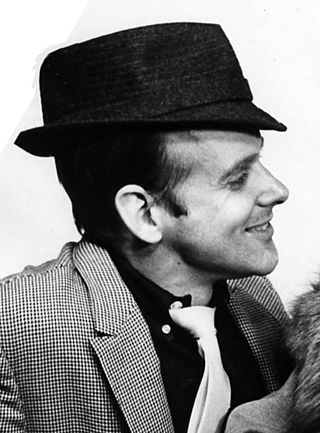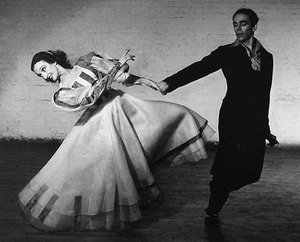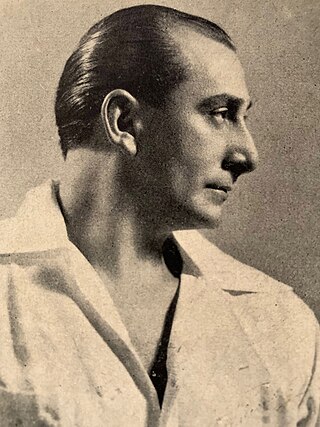Related Research Articles

West Side Story is a musical conceived by Jerome Robbins with music by Leonard Bernstein, lyrics by Stephen Sondheim, and a book by Arthur Laurents.

Robert Louis Fosse was an American actor, choreographer, dancer, and film and stage director. He directed and choreographed musical works on stage and screen, including the stage musicals The Pajama Game (1954), Damn Yankees (1955), How to Succeed in Business Without Really Trying (1961), Sweet Charity (1966), Pippin (1972), and Chicago (1975). He directed the films Sweet Charity (1969), Cabaret (1972), Lenny (1974), All That Jazz (1979), and Star 80 (1983).

Oklahoma! is the first musical written by the duo of Rodgers and Hammerstein. The musical is based on Lynn Riggs's 1931 play, Green Grow the Lilacs. Set in farm country outside the town of Claremore, Indian Territory, in 1906, it tells the story of farm girl Laurey Williams and her courtship by two rival suitors, cowboy Curly McLain and the sinister and frightening farmhand Jud Fry. A secondary romance concerns cowboy Will Parker and his flirtatious fiancée, Ado Annie.

Fiddler on the Roof is a musical with music by Jerry Bock, lyrics by Sheldon Harnick, and book by Joseph Stein, set in the Pale of Settlement of Imperial Russia in or around 1905. It is based on Tevye and his Daughters and other tales by Sholem Aleichem. The story centers on Tevye, a milkman in the village of Anatevka, who attempts to maintain his Jewish religious and cultural traditions as outside influences encroach upon his family's lives. He must cope with the strong-willed actions of his three older daughters who wish to marry for love; their choices of husbands are successively less palatable for Tevye. An edict of the tsar eventually evicts the Jews from their village.

The Music Man is a musical with book, music, and lyrics by Meredith Willson, based on a story by Willson and Franklin Lacey. The plot concerns con man Harold Hill, who poses as a boys' band organizer and leader and sells band instruments and uniforms to naïve Midwestern townsfolk, promising to train the members of the new band. Harold is no musician, however, and plans to skip town without giving any music lessons. Prim librarian and piano teacher Marian sees through him, but when Harold helps her younger brother overcome his lisp and social awkwardness, Marian begins to fall in love with him. He risks being caught to win her heart.

Hairspray is an American musical with music by Marc Shaiman and lyrics by Marc Shaiman and Scott Wittman, with a book by Mark O'Donnell and Thomas Meehan, based on John Waters's 1988 film of the same name. The songs include 1960s-style dance music and "downtown" rhythm and blues. Set in 1962 Baltimore, Maryland, the production follows teenage Tracy Turnblad's dream to dance on The Corny Collins Show, a local TV dance program based on the real-life Buddy Deane Show. When Tracy wins a role on the show, she becomes a celebrity overnight, leading to social change as Tracy campaigns for the show's integration.

Doris Batcheller Humphrey was an American dancer and choreographer of the early twentieth century. Along with her contemporaries Martha Graham and Katherine Dunham, Humphrey was one of the second generation modern dance pioneers who followed their forerunners – including Isadora Duncan, Ruth St. Denis, and Ted Shawn – in exploring the use of breath and developing techniques still taught today. As many of her works were annotated, Humphrey continues to be taught, studied and performed.

Dolores Conchita Figueroa del Rivero, known professionally as Chita Rivera, was an American actress, singer, and dancer. Rivera received numerous accolades including two Tony Awards, two Drama Desk Awards, and a Drama League Award. She was the first Latina and the first Latino American to receive a Kennedy Center Honor in 2002, and the Presidential Medal of Freedom in 2009. She won the Tony Award for Lifetime Achievement in 2018.

Susan P. Stroman is an American theatre director, choreographer, film director and performer. Her notable theater productions include Oklahoma!, The Music Man, Crazy for You, Contact, The Producers, The Frogs, The Scottsboro Boys, Bullets Over Broadway, POTUS: Or, Behind Every Great Dumbass Are Seven Women Trying to Keep Him Alive, and New York, New York.
Onna White was a Canadian choreographer and dancer, nominated for eight Tony Awards.
Peter Gennaro was an American dancer and choreographer.

Ann Reinking was an American dancer, actress, choreographer, and singer. She worked predominantly in musical theater, starring in Broadway productions such as Coco (1969), Over Here! (1974), Goodtime Charley (1975), Chicago (1977), Dancin' (1978), and Sweet Charity (1986).

Contact is a musical "dance play" that was developed by Susan Stroman and John Weidman, with its "book" by Weidman and both choreography and direction by Stroman. It ran both off-Broadway and on Broadway in 1999–2002. It consists of three separate one-act dance plays.

Chita Rivera: The Dancer's Life is a musical revue based on the life of Chita Rivera, with a book by Terrence McNally, original songs by Stephen Flaherty and Lynn Ahrens, and additional songs from various other composers' catalogs. It earned Rivera her ninth Tony Award nomination.

Baayork Lee is an American actress, singer, dancer, choreographer, theatre director, and author.
Graciela Daniele is an Argentine-American dancer, choreographer, and theatre director.
Lynne Taylor-Corbett is a choreographer, director, lyricist, and composer. She was born in Denver, Colorado.
The American Dance Machine was a theatrical dance company created by Lee Theodore, which played on Broadway at the Century Theatre, opening Jun 14, 1978 and in total running 199 performances. It was duplicated with a second cast for the American Dance Festival at Duke University in 1978. The show was a "Living Archive" of Broadway theatre dance; great theatre dances saved from oblivion. Films were made of the performances to preserve original Broadway choreography and can be found at the Lincoln Center Library of the Performing Arts in New York City. Broadway legend Gwen Verdon appeared a film version of the show in 1981 for Showtime. Choreographers included: Agnes De Mille, Jack Cole, Joe Layton, Michael Kidd, Ron Field, Bob Fosse, Onna White and Peter Gennaro. Featured dancers and guest artists included Janet Eilber, Carol Estey, Harold Cromer, Liza Gennaro, Patti Mariano, Nancy Chismar and Donald Young.
Vernal "Buzz" Miller was an American dancer who was equally at home on Broadway and in contemporary ballet and modern dance.

Gluck Sandor (1899–1978), aka Senia Gluck-Sandor, was an American artist, dancer, director, producer, actor, mime and teacher. He made his stage debut in the Met Opera production of Le Coq d'Or in 1918, and continued to choreograph, dance, and act in several Broadway productions from the 1920s through the early 1970s. He married dancer and choreographer Felicia Sorel, and in 1931 they opened The Intimate Theatre in New York City where they taught dance, mime, choreography, and dance theory. In 1930 he went to Europe to study with the Wigman school of Modern Dance and returned to N.Y. in September 1931. Sandor and Sorel, established "The Dance Center" a dance school and a professional dance company of the same name. In 1977, a retrospective exhibition of Sandor's paintings toured small galleries in Florida and New York. Gluck Sandor died in 1978 in New York City.
References
- ↑ Archived June 17, 2020, at the Wayback Machine , Aellea Classic Movie Scripts (1957), accessed August 23, 2023
- ↑ Archived April 1, 2023, at the Wayback Machine , Playbill (vault), accessed August 23, 2023
- ↑ https://www.discogs.com/master/181208-Leonard-Bernstein-Jerome-Robbins-Carol-Lawrence-Larry-Kert-Chita-Rivera-Art-Smith-West-Side-Story
- ↑ Archived April 1, 2023, at the Wayback Machine , Playbill (vault), accessed August 23, 2023
- ↑ Archived April 1, 2023, at the Wayback Machine , Playbill (vault), accessed August 23, 2023
- ↑ https://www.imdb.com/name/nm0857483/
- ↑ https://www.adm21.org/history
- ↑ https://www.bruxellons.be/WWMusicalsBioArtiste.php?artiste=Lee%20Becker%20Theodore
- ↑ Burke, Siobhan (2015-12-16). "American Dance Machine for the 21st Century Keeps Classic Moves Alive". The New York Times. ISSN 0362-4331 . Retrieved 2023-09-14.